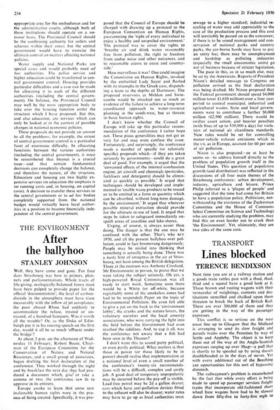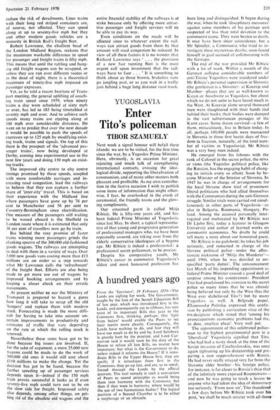TRANSPORT
Lines blocked
TERENCE BENDIXSON
Next time you are at a railway station and a goods train rattles past with a thud, thud, thud and a squeal have a good look at it. Those brown and rusting wagons with their vernacular of weightings, contents and des- tinations stencilled and chalked upon them threaten to break the back of British Rail. There are over 300,000 of them and they are getting in the way of the passenger expresses.
This conflict is so serious on the west coast line up to Glasgow that the Midland is arranging to send its slow freight and parcels trains over the Pennines by way of Settle and Appleby. The object is to keep them out of the way of the Anglo-Scottish expresses surging up over Shapa pull that is shortly to be speeded up by using diesels doubleheaded as in the days of steam. Yet with every additional cut of the Beeching axe opportunities for this sort of bypassing diminish.
The railwaymen's problem is exacerbated by the fact that while every effort is being made to speed up passenger services freight trains that incorporate old-fashioned short wheel base wagons have had to be slowed down from fifty-five to forty-five mph to reduce the risk of derailments. Liner trains with their long red striped containers are, of course, not affected. They can speed along at up to seventy-five mph but they and other modern goods vehicles are a minority in British Rail's freight fleet.
Robert Lawrence, the ebullient head of the London Midland Region, reckons that the maximum workable difference in speed for passenger and freight trains is fifty mph. This means that until the rattling and bang- ing old freight wagons can be scrapped, or unless they are run over different routes or in the dead of night, there is a theoretical maximum of ninety-five mph imposed on passenger expresses.
Yet, as he told a recent Institute of Trans- port meeting, the general uplifting of coach- ing train speed since .1959, when ninety trains a day were scheduled at sixty mph or over, has led to 185 being timetabled at seventy mph and over. And to achieve such speeds many trains are zipping along at 100 mph over considerable distances. He went on to predict that over the next decade it would be possible to push the speeds of expresses up to 125 mph by modifying exist- ing track, trains and signals. On top of this there is the prospect of the 'advanced pas- senger trains', now being developed at Derby, coming into experimental use in the next few year and doing 150 mph on exist- ing tracks.
The improved city centre to city centre timings promised by these speeds, coupled with more comfortable carriages and in- creasing road congestion, lead the railways to believe that they can capture a further share of 'inter-city' travel. This is based on their experience with the Midland line where passengers have gone up by 76 per cent to Manchester and 56 per cent to Coventry-Birmingham since electrification. One measure of the passengers still waiting to be wooed aboard is the Sheffield to London route where it is estimated that only 38 per cent of travellers now go by train.
But behind the rosy promise of faster trains winning more passengers grinds the clanking spectre of the 300,000 old-fashioned goods wagons. The railways are attempting to deal with them in a variety of ways. Over 3,000 new goods vans costing more than ft 3 millions are on order as a step towards what Mr Lawrence calls the 'refreshment' of the freight fleet. Efforts are also being made to get more use out of wagons by improved booking arrangements and by keeping a closer check on their erratic movements.
At present neither BR nor the Ministry of Transport is prepared to hazard a guess how long it will take to scrap all the old 'bangers' and replace them with modern stock. Forecasting is made the more diffi- cult for having to take into account un- certain improvements in productivity and estimates of traffic that vary depending on the rate at which the rolling stock is renewed.
Nevertheless these sums have got to be done because big issues are involved. If, for the sake of argument, a mere 25,000 new wagons could be made to do the work of 300,000 old ones it would still cost about £1 10 millions to make the change. Yet the decision has got to be faced, because the further speeding up of passenger services depends upon it—indeed if the 150 mph train proves successful it looks as if even seventy-five mph could turn out to be on the slow side for freight. Improved safety also depends, among other things, on get- ting rid of the obsolete old wagons and the entire financial stability of the railways is at stake because only by offering more attrac- tive passenger and freight services will BR be able to pay its way.
Even conditions on the roads will be affected since to whatever extent the rail- ways can attract goods from them by that amount will road congestion be reduced. In view of all these factors it is no wonder that Richard Lawrence says . . . the provision of a new fast running fleet is the most urgent call upon investment that the rail- ways have to face . . . ' It is something to think about as those brown, brakeless vans go jangling past, or as you wait in a traffic jam behind a huge long distance road truck.



































 Previous page
Previous page